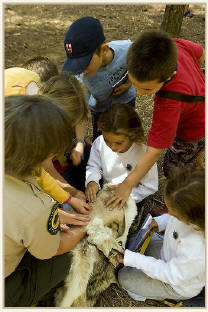|
 Parks and park
associations frequently talk about "education & interpretation" and
"interpretive
programs".
Many parks have "interpreters" or "interpretive specialists". And
the signs and panels you see around a
park that explain the wildlife or geology are traditionally called
"interpretive panels". So what's interpretation
at a park all
about? Parks and park
associations frequently talk about "education & interpretation" and
"interpretive
programs".
Many parks have "interpreters" or "interpretive specialists". And
the signs and panels you see around a
park that explain the wildlife or geology are traditionally called
"interpretive panels". So what's interpretation
at a park all
about?
Interpretation is communication
about the park and its features that goes
beyond facts in order to reveal what things mean, how they fit
together, and why they matter to the visitor. Interpretation
is a heightened level of education.
For example, imagine
you're preparing to hike on Doane Valley Nature Trail and
you've picked up some basic facts from reading the park brochure
or a blog: its length, elevation, some of the species of trees you'll see,
and so on. You might even grab a copy of the self-guided tour
brochure to take along. Good, you've been educated.
Imagine, though, walking that same trail
with a park interpreter as your guide. The interpreter could
be an interpretive specialist or the ranger, or even a park aide or volunteer... someone who
understands the history of the area, who knows the flora and
fauna, and so on. He or she is in tune with the park's rhythms
and is able to point out things you might miss, such as a
special bird calling in the tree canopy above, a medicinal plant
tucked away out of sight, signs of wildlife foraging in
the area, or remnants of a historical site that you might not
notice. Your interpreter will likely go one step further: explain
how the bird fits in the park's history, why the plant was so
important to the native Americans and settlers, how
distinguish a buck's print from a doe's, and why the
archeological remains are so important to the park's history.
Finally, he or she will probably explain what all this means to
you. This is interpretation.
Also, an interpreter
will modify his or her interpretation to suit the "student";
interpretation for a group of middle-aged visitors could be much different
compared to interpretation for a pack of Cub Scouts. |